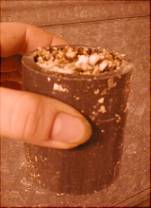Unlike greenhouses in the U.S., the McMurdo Greenhouse is not made of glass. It is too cold for that! Instead, it is a sealed and insulated building, with a giant refrigerator door to get inside. "Sunlight" comes from high intensity discharge lamps, and the walls are covered in reflective foil to increase the light intensity from the lamps. To maintain a proper temperature, the greenhouse is heated by a furnace at night and the lamps during the day.
[photo credit: www.schundler.com]
 Because Antarctica's environment is protected by the Antarctic Conservation Act, we are not able to import gardening soil to grow vegetables here. So, the greenhouse uses a hydroponic system to grow vegetables, meaning that vegetables are grown in water instead.
Because Antarctica's environment is protected by the Antarctic Conservation Act, we are not able to import gardening soil to grow vegetables here. So, the greenhouse uses a hydroponic system to grow vegetables, meaning that vegetables are grown in water instead.How this works: Each plant is seeded in a "plug". The plug is a short piece of PVC pipe. In the pipe, there's a combination of vermiculite and Perlite (little pellets that you can buy from a company), which give the roots of the plant something to hold onto. The plugs are then placed in the shelves you see in the photo above. The shelves have a circulating reservoir system of water moving through them. The water is heated and aerated, and nutrients are added to the water to be carried directly to the plants growing in the plugs on the shelf. That gives the plant everything it needs! Each day, measurements are made on the water, and the nutrient content and pH are adjusted by hand. All of the water is recycled within the reservoir system for that shelf. There is a separate reservoir system for each type of plant, so water from the peppers doesn't mix with the water for the tomatoes. All of this is maintained by just one person!
The greenhouse grows a variety of vegetables. In the past, we've had lettuce, spinach, chard, cucumbers, tomatoes, peppers, herbs, and even flowers! The harvests are mainly useful for the winter crew, when airplanes aren't able to deliver fresh vegetables from New Zealand. The greenhouse can provide enough vegetables for the winter crew (up to 230 people) to have a salad every few days, plus some veggies for the cook to use in regular meals. During the summers, the population at McMurdo is too big for the greenhouse to supply completely, so it can only supplement the shipments of "freshies" flown down from New Zealand. But, more importantly, it provides a little piece of "summer" relaxation to the folks experiencing months of cold and gray, and many people visit just for the atmosphere.
Besides the great environment for relaxation and the ability to eat fresh vegetables, I've used the greenhouse in the past to test out our field equipment. The machines we use to measure gas flux (the LICOR) can measure not only soil respiration, but also photosynthesis (which is, essentially, the reverse process of respiration. So, instead of measuring a production of CO2, the machine measures a reduction in CO2.) Since the mosses we study in the dry valleys are so slow-growing, we need to know that the LICOR is working perfectly to measure such small amounts of photosynthesis before we take it to the field. The best place to test out the machinery is in a place where there's a lot of photosynthesis: a greenhouse!
However, this year, they decided not to open the greenhouse for the summer and rely completely on shipments of freshies, which is very unfortunate. I miss my regular visits with the plants, and we couldn't test our LICOR! I hope they change their mind for next summer.







hi mr.lepine and the aqua/hydroponic team says hi. this is the only boys blog on the team. what your doing is AWESOME. p.s. reply back plz
ReplyDeleteHello, Mr. Lepine's class!
ReplyDeleteI hope you liked reading about hydroponics in Antarctica. One of the things that fascinates me about Antarctica is how ingenious and adaptable people are here. I'm in one of the most inhospitable climates on Earth, and here we are with a vegetable garden! All because of the technology that you guys are being trained in now. What's next? Maybe one day you'll all be part of the hydroponics team on Mars. :)